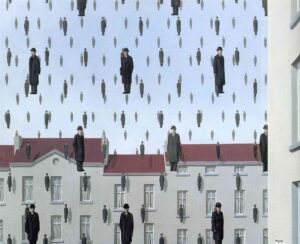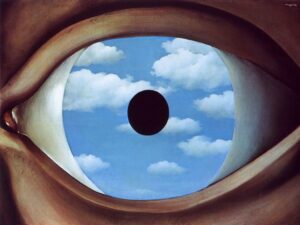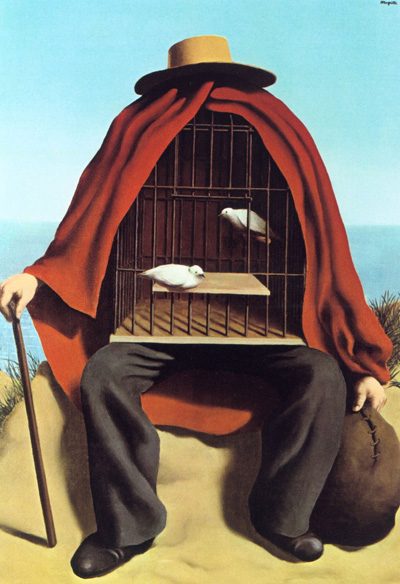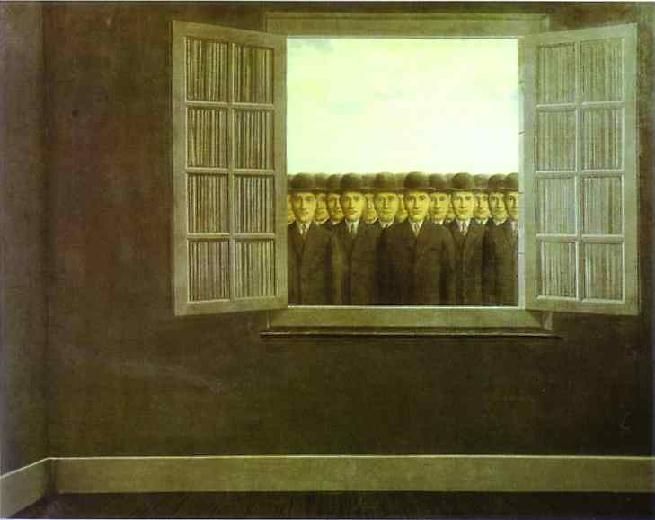The Marvels of a Floating City
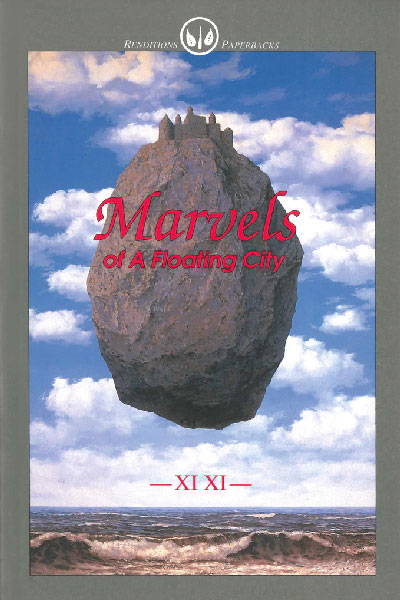
“Marvels of a Floating City” tells a Hong Kong story through 13 paintings by the Belgian painter René Magritte. The Sino-British Joint Declaration was signed in 1984 and determined the handover of Hong Kong’s sovereignty in 1997. How should the people living in the city ponder their future? This short piece, completed in April 1986, was a timely response to the critical situation. Influenced by Calvino’s concept of “time zero”, this work of fiction does not focus on narrating a “complete” story with a beginning and an end, but focuses on the moment by inviting readers to contemplate the city through 13 surrealist paintings full of contradictions and tensions. Xi Xi’ s appropriation of the image of the floating city has now become a symbol of Hong Kong. Reading and writing can be seen as a dialogue, and by reading the anxieties of ones’ own times into these paintings, Magritte’s paintings are no longer just distant works of art for us to admire from afar. Xi Xi demonstrated how to turn artistic creation into a resource for active intervention in society.
I. Floating City
Many, many years ago, on a fine, clear day, the floating city appeared in the air in full public gaze, hanging like a hydrogen balloon. Above it were the fluctuating layers of clouds, below it the turbulent sea. The floating city hung there, neither sinking nor rising. When a breeze came by, it moved ever so slightly, and then it became absolutely still again.
How did it happen? The only witnesses were the grandparents of our grandparents. It was an incredible and terrifying experience, and they recalled the event with dread: layers of clouds collided overhead, and the sky was filled with lightning and the roar of thunder. On the sea, a myriad pirate ships hoisted their skull and crossbones; the sound of cannon fire went on unremittingly. Suddenly, the floating city dropped down from the clouds above and hung in mid air.
Many, many years passed, and in time our grandparents’ grandparents all passed away. Even our own grandparents went to their eternal sleep one after another. The events of the past which they had related became obscure legends.
The descendants of these grandparents settled down in the floating city and gradually adapted themselves to its conditions. The legends of the floating city faded in their memory. Most people believed that the floating city would continue hanging steadily in the air, neither rising nor sinking, for ever. When the wind blew, it would sway only a little, just like the pleasant motion of a swing.
And so many, many more years have passed.
II. A Miracle
You need courage to live without roots. This is written on the title page of a novel. To live in a floating city, however, you need more than courage; you need will-power and faith as well. There is another novel which mentions a nonexistent knight—he is just an empty suit of armour. Charlemagne asked him: So, how do you sustain your life? He answered: With will-power and faith.
Though this is just a floating city, the people here have, on the sheer strength of their faith and will-power, strived to build a home fit to be lived in. In just a few decades, their pioneering spirit and hard work have paid off: the floating city has become a vibrant and prosperous metropolis.
Buildings shoot up from the ground, each one taller than the next. Flyovers circle the air space above road junctions. Trains, centipede-like, crawl underground and all over the suburbs. Kidney stones are shattered by laser beams; brain tumours are diagnosed by scanning. Those interested in the Haley’s Comet can follow its track in the Planetarium; those interested in the life of sea lions can observe them at Ocean Park. Nine years’ compulsory education; social security; allowances for the disabled; pension schemes—all these have come into being. There are several art festivals a year, and the bookstores stock books from all over the world. Those who choose to remain silent have absolute freedom to do so.
People find it is almost unbelievable that buildings in the floating city can float in the air; that flowers grown in the floating city are each big enough to fill a whole room. People say the existence of the floating city is truly a miracle.
III. Sudden Showers
The period from May to September is the typhoon season in the floating city. Strong winds blow from all directions, and the floating city rocks and sways. The people who live here are used to all this rocking and swaying and carry on with their work and horse racing undisturbed. Experience tells them that even in the typhoon season, the floating city never gets blown upside down, nor does it get blown away.
There is just one thing somewhat special about the typhoon season, and that has to do with the dreams of its citizens. With the arrival of May, people in the floating city start dreaming the same dream. In this dream everyone is floating in mid air; they neither rise up to the heavens, nor do they drop down to earth—everyone is just like a small floating city. The floating humans do not have wings, which means they cannot fly. All they do is stay afloat in the air, silently, and solemnly, with no means of communication between them. The city sky is afloat with people like raindrops in an April shower.
With the arrival of May people start dreaming their floating-human dreams. Even those who take a nap in the daytime have the same dream—they stand silently and solemnly in mid air. Such dreams do not disappear until September. When the typhoon season is over, people in the floating city start dreaming their individual dreams again.
Why should everyone in the city share the same dream of being afloat in the air? One school of psychologists has drawn this conclusion: this is a collective manifestation of the Third-Side-of-the-Straits Complex.
IV. Apple
It is summer. On many streets and lanes of the floating city there appears a poster of an apple with one line written in French at the top. It says: Ceci n’est pas une pomme. It is only natural that this poster should appear, because the city is to hold a large-scale retrospective of the works of the Belgian painter René Magritte. The painting with the apple is part of the exhibition.
“Ceci n’est pas une pomme.” What does it mean? There can be no mistake that the picture is that of an apple. What the artist actually means is that the apple in the picture is not an edible apple. If you stretch out your hand, you will not be able to grab hold of it; if you sniff it, you will not smell the scent of an apple; if you cut it open, you will not get the flesh and juice of real fruit. And so the apple in the picture is not a real apple, only lines, colours and shape—an illusion. Didn’t the Greek philosopher Plato say that the picture of a bed, however well drawn, however real it looks, remains no more than an imitation of the bed?
Though the poster of Magritte’s painting appears in all the streets and lanes, those who attend the exhibition will number no more than 0.1% or 0.2% of the population. However, the fact that these apples should appear in every corner of the city is rather fun—many people actually think it is a publicity campaign for the fruit market. Only a handful of intellectuals are struck by an idea: the floating city, despite its absolute steadiness, is also an illusion. The miracle of the floating city is, after all, not a fairy tale.
V. Eyes
“Cinderella” is a fairy tale: a pumpkin turns into a carriage, mice turn into steeds, and rags turn into a beautiful ball gown. But when the clock strikes midnight, everything reverts to its drab old self. Is the floating city just another Cinderella story?
It is not that people in the floating city don’t have eyes that see clearly. They are technologically advanced, and they have the best microscopes and telescopes. They are always looking down at the ocean, or up at the sky, or testing the wind direction. What is it that enables this floating city to stay so steadily in the air? Could it be the gravitational pull between ocean and sky? Or could it be a marionette performance staged by the god of destiny holding numerous invisible strings in his hands?
The picture of an apple is not a real apple, so perhaps a floating city whose existence depends on a miracle is not a permanent city. In that case, is its destiny really in its own hands? What if the gravitational forces of the ocean and the sky change, or if the god of destiny tires of his game? Will the floating city soar upward, or sink, or be blown away to some unknown place and never be heard of again?
Their eyes wide open, the people of the floating city look downward. If the floating city sinks, the billowing ocean under their feet will swallow the whole city. Even if the city manages to stay afloat, pirate ships flying the skull and crossbones will come and sack the city. If the floating city soars upwards, will the soft, wispy clouds be able to bear the weight of such a solid metropolis?
VI. Problem
There are no big rivers in the floating city, and since sea water is undrinkable, the floating city depends on the mercy of heaven for its drinking water. That is why although people here like bright sunny days, they cannot but also long for thunder storms.
A teacher takes a group of students to City Hall to see an exhibition of Magritte’s paintings. The students all put pen to paper, writing down their reaction and the titles of the paintings. They ask: This umbrella with a glass of water on it, what does it mean? And why is it called Hegel’s Holiday? They try to find an answer in the exhibition catalogue.
At different times, people have different attitudes towards water. Sometimes they accept it, and sometimes they reject it. For instance, people drink when they are thirsty, which means they allow the water to go into their; but on rainy days they all hold up their umbrellas to prevent water from touching their body. Acceptance and rejection, external and internal, these are questions for philosophers. As for the subject of water, perhaps a philosopher like Hegel may be interested in pondering it for a while, but since it is a very limited subject, it’s likely that he’d only think about it in his spare time on a holiday.
A student looks at the painting for a long time, then asks: Umbrellas are for protecting people from getting wet in the rain. Now since the water is contained in a glass, there should not be any need for the umbrella. What is there to reject? That’s true. If there are solid clouds above the floating city, then it would be a good thing for it to soar up to the skies. What is there to reject?
VII. Flora
The majority of the floating city’s inhabitants are men with hats—a symbol of the petty bourgeoisie. They want a society that is stable and prosperous, a home that is warm and quiet, and so they work as hard as bees and ants; for work is the best antidote for sadness. The hard work of these citizens bears fruit in the form of a well-clad, well-fed, wealthy and bustling modern society. But inevitably such a society is full of material temptations enticing people to work harder and harder, and eventually dragging them into the black hole of material possessions.
Sandro Botticelli was an Italian Renaissance painter. In one of his paintings, entitled “Spring”, he depicts the images of deities who bring the news of spring to earth: Hermes the messenger-god leads the way; Cupid flies above Venus; and the West Wind walks next to Flora. The three Graces dance along while the Goddess of Spring, clad in a diaphanous colourful dress, sprinkles blossoms over the fragrant meadows.
Our Song dynasty painter Li Gonglin for his part painted a picture of “Verishnu Preaching”. On the instruction of Sakyamuni, the Boddhisatva Manjusri took his disciples to visit Verishnu, who had taken ill. While Verishnu lectured the group on the principles of Mahayana Buddhism, a diva standing at his side scattered flowers all around, and Manjusri’s leading disciple had his robe covered in flowers.
The prosperous floating city is full of material temptations. People here all wish the diva’s flowers would fall on them, and they go so far as to carry the goddess of spring with all her blossoms on their back, like a knapsack.
VIII. Time
This is the critical moment; this is the absolute moment—a train engine arrives. Before this moment, the engine has not yet entered the fireplace; after this moment, the engine will have departed. It is only at this particular moment that the engine steams into the fireplace in this room; it is only at this absolute moment that the smoke from the engine can rise up the chimney: and the chimney is of course the only proper outlet for smoke.
A fireplace reminds one of Christmas festivities—a time of glad tidings for the whole city. But from the look of the room we can see it is not festival time: there are no gift stockings hanging from the mantelpiece, no pine tree in the room, no shimmering lights, no angels, no silver bells, and no candles in the candlesticks.
The marble clock on the mantelpiece has its hour hand approaching one and its minute hand approaching nine; the position of its second hand is uncertain. It’s past midnight. Had there been a carriage, it would have turned back into a pumpkin; had there been steeds, they would have turned back into mice; and the beautiful ball gown is again just rags.
Yes, it’s past midnight. But as the story goes, Cinderella meets her Prince Charming before midnight. Is the floating city’s Prince Charming waiting somewhere around the stroke of midnight? Although he rides a white steed, it boasts only one horse-power. Maybe he is late.
Zero hour always has people worried. What will the hour one be like? Perhaps people can see the future in a mirror?
IX. Mirror on the Wall
Only those who have been to the floating city know about its mirrors—they are totally different from ordinary mirrors. In the fairy tale “Snow White and the Seven Dwarfs”, the wicked Queen has a magic mirror on the wall which answers her question “who’s the fairest of them all?” It is an honest mirror; it never lies. The floating city’s mirrors are all honest mirrors, too. They are keen to reflect reality. However, even mirrors have their limitations, and the mirrors in the floating city only reflect the back view of things.
All mirrors, whether locally made or imported from abroad, reflect only the rear side of things as soon as they are hung on the walls of buildings in the floating city. And so when people in the floating city look at themselves in the mirror, they don’t see their faces, only the hair at the back of their head. Someone tried placing one mirror in front of another, but whatever you do, however many mirrors you use and whatever the angles you place them at, the mirrors only reflect the rear side of reality. That’s why the floating city’s women have to visit beauty parlours—it’s very difficult for them to do their own make-up. The same goes for the men—for a really good shave they have to go to a barber.
In the floating city, you cannot find the answer or predict the future by looking at a mirror. However, to be able to see the past is by no means a bad thing. History is a mirror, and that is one positive aspect of the mirrors in the floating city.
X. Wings
Modes of transportation in the floating city are diverse: from ancient rope ladders and balloons to modern helicopters and parachutes. Those who want to have a look above the clouds can climb up a rope ladder or ride up in a balloon; those who want to have a look at the sea can descend in a parachute or a helicopter. However, the majority of the citizens wish they had wings. When all is said and done, these people feel that to live in a city that is floating in the air is a scary thing. Those most worried brood over it day and night, and finally decide to pack up and leave, like migratory birds. They will build their ideal nests somewhere else.
A novelist records something like this: Someone went to an embassy to apply for migration, and the official in charge asked where he wanted to go. Doesn’t matter, he replied. The official handed him a globe and told him to take his pick. The man looked at the globe, turned it around slowly, and then asked: Do you have another one?
Where does one go if one leaves the floating city? That’s a tough question. Where can one find a solid city where one can live forever in peace? Besides, those who leave must have sturdy wings, and they must be very careful during their flight. They must not get too close to the sun, or the wax will melt, and they will fall from the sky as Icarus did.
The inhabitants of the floating city are not migratory birds. If they leave, they will not be able to return. Can one just pick up one’s walking stick and knapsack, and leave without looking back? Though the people of the floating city long to be winged pigeons, in their hearts they are repressed, caged birds.
XI. Bird-grass
Their wish to fly means the people of the floating city are always looking up at the sky. Despite this, they don’t have the ability to fly, nor can they create the flowing sashes of the flying divas in the Dunhuang caves. In the typhoon season all they can do is dream; they dream that they are floating silently in the air, but even though they are in mid-air, they still cannot fly.
After the typhoon season, people return to their own dreams. They dream of box kites, of drifting snowflakes, of graceful butterflies, of thistle down; some even dream of the floating city sprouting wings. But when they wake up, they find that they are still firmly attached to the ground of the floating city. Surprisingly, this ground gives rise to a strange plant which our biological world has never witnessed before—the bird-grass.
The floating city is covered in green. All over its urban areas and suburbs, beside all its streams, over all its hills and valleys, in all its gardens and parks, there now grows the luxuriant dark green bird-grass. This is an unusual plant: its flat leaves are in the shape of birds. Pick a leaf, and you’ll see clearly the bird’s head, beak and eyes. Even the surface of the leaf feels like bird feathers. When a breeze comes along, the grass rustles like birds flapping their wings.
Though the bird-grass looks like birds, it is nevertheless grass. None of its leaves has wings. People say that if it had wings, then the bird-grass would be able to fly. The sky above the floating city would then be filled with flying bird-grass, and no one would be able to tell whether they were birds or grass, animal or plant.
XII. Child Prodigies
In the same year the bird-grass appeared, the floating city had its first child prodigies. They are children of exceptional intelligence. These children do not arouse much attention at birth—they are just normal-looking plump and soft-skinned babies. But these children grow exceptionally quickly both physically and in terms of intelligence. In no time at all they become strong, agile and mature-thinking big boys and girls.
It probably starts with their arithmetic homework. Their mothers watch as they do their exercises, and cannot understand why addition, subtraction, multiplication and division are done with coloured blocks of wood rather than with pen and pencil. And if 480 grains make an ounce, then why should grain be measured in kilos? And what is this thing called “set”? As time goes by, the mothers find themselves unable to understand any of their children’s school books. Moreover, the children don’t need to open any books any more; they just turn on the TV or put on a pair of earphones.
First, the children tell their mothers to keep the bathroom window open when they take a hot shower* and not to use too much salt when they cook. Then they take their mothers on trips, treat them to delicacies and buy them presents. The mothers feel that they are becoming more and more like babies, while their children become the pillars of the family, taking over from them as parents, subverting their traditional role of authority. Many mothers are scared, not knowing what to do about all this.
A small number of mothers, however, are delighted. They have always had doubts and worries in their heart, problems which they cannot solve. Now when they think about these child prodigies, they figure that perhaps everything will be resolved in the children’s hands.
* To prevent gas-poisoning caused by old-fashioned single-flue water heaters.
XIII. Windows
The earth is only a tiny planet in the universe, and the floating city is only a tiny city on the earth. If you look at a map, you’ll find that the size of the floating city is like a pin-prick; even its name doesn’t seem to exist. However, tiny though it is, this city has gradually attracted the attention of people in far-away places.
A city floating in the air; mirrors which only show the back view of things; people floating in dreams during the typhoon season; bird-grass that grows in the soil . . . . This fantastic city has drawn numerous travellers to explore and experience it, to look in its mirrors and to dream its dreams. As for those who haven’t come, it’s not that they are not curious about the city; no, many of them are actually quite concerned about it. And so they stand outside and look into the city through an open window. Their hands hang by their sides, making it obvious that they cannot offer any practical assistance. But to observe is a kind of participation, too, for to observe is to monitor.
The observers at the window—what do they see now? They see a teacher taking a group of students to an exhibition of Magritte’s paintings at the City Hall. The walls are lined with paintings, and people walk around in twos and threes. Suddenly, the observers at the window come face to face with the students and their teacher. From the solemn looks on the observers’ faces one can detect how things are going. If it is a tragedy, their faces will be sorrowful; if it is a comedy, they will of course smile.
At the other end of the room, workers are putting up a Mona Lisa poster on the notice board announcing forthcoming events. Over here, the people in the painting and those who have come to see the painting are staring at one another through a window, deep in thought.
Translated by Eva Hung
Three Texts by XiXi
Find a list of useful links to websites, databases and scholarly articles related to Xi Xi’s literary works.
Since November 2021, we have organized various writing workshops both online and in person, in areas such as Sham Shui Po, Wan Chai, Kowloon Tong, etc. Learn more about these workshops.
©2025 - All rights Reserved. Our Xi Xi Our City.


